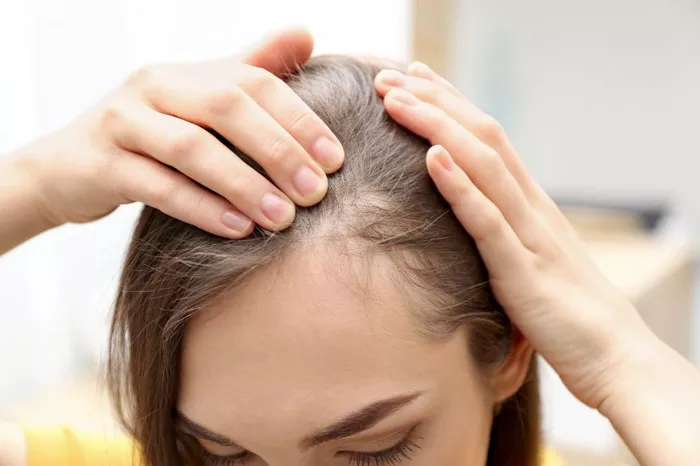Hair loss can be stressful, confusing, and even embarrassing. If you’ve noticed more hair in your brush, on your pillow, or clogging the shower drain, you’re probably asking: Why is this happening? As a hairstylist, I’ve seen countless clients struggle with this issue. While I’m not a doctor, I can share common reasons behind hair loss, based on what experts say and what I’ve observed over the years.
This article will break down the causes, explain how to identify them, and offer practical tips to help you take action. Let’s dive in.
Genetics: The Most Common Culrit (Androgenetic Alopecia)
If your parents or grandparents had thinning hair, you might be genetically prone to hair loss. This type of hair loss, called androgenetic alopecia, affects both men and women.
How it works: A hormone called DHT (dihydrotestosterone) attacks hair follicles, making them shrink over time. Hair grows thinner, shorter, and eventually stops growing.
Patterns:
Men: Receding hairline, bald spots on the crown.
Women: Thinning along the part line or overall scalp visibility.
What to do:
-
- See a dermatologist for treatments like minoxidil (Rogaine) or finasteride (for men).
- Low-level laser therapy (LLLT) caps can stimulate growth.
- Hair transplants are a long-term option.
Hormonal Changes: Your Body’s Hidden Triggers
Hormones play a huge role in hair health. Imbalances can lead to sudden shedding. Common causes include:
Thyroid Issues
An overactive (hyperthyroidism) or underactive (hypothyroidism) thyroid disrupts the hair growth cycle.
- Signs: Fatigue, weight changes, dry skin, or brittle nails alongside hair loss.
- Fix: Blood tests can diagnose thyroid problems. Medication often restores balance and hair growth.
Pregnancy and Postpartum Shedding
During pregnancy, high estrogen levels keep hair in the growth phase. After childbirth, hormones drop, causing hair to enter the shedding phase (telogen effluvium).
- Timing: Shedding peaks 3–6 months postpartum.
- Outcome: Hair usually regrows within 6–12 months.
Menopause
Declining estrogen and progesterone levels during menopause can make hair thinner and weaker.
Stress: The Silent Hair Killer
Physical or emotional stress pushes hair follicles into a “resting” phase, leading to sudden shedding 2–3 months later. This is called telogen effluvium.
Causes:
- Surgery, illness, or injury.
- Severe emotional stress (divorce, grief, work pressure).
Recovery: Hair often regrows once stress is managed.
Nutritional Deficiencies: Your Diet Matters
Hair needs vitamins, minerals, and protein to grow. Crash diets, vegan/vegetarian lifestyles, or poor eating habits can starve your follicles.
Key Nutrients Linked to Hair Loss
- Iron: Low iron (common in women) reduces hemoglobin, which carries oxygen to hair roots.
- Vitamin D: Deficiency is linked to alopecia areata (patchy hair loss).
- Protein: Hair is made of keratin (a protein). Inadequate protein intake weakens strands.
- Zinc and Biotin: Support hair structure and growth.
Fix:
- Eat iron-rich foods (spinach, red meat) or take supplements (with a doctor’s advice).
- Include eggs, nuts, fish, and leafy greens in your diet.
Medical Conditions and Scalp Health
Certain illnesses or scalp issues directly damage hair follicles.
Alopecia Areata
An autoimmune disease where the body attacks hair follicles, causing round bald patches.
- Treatment: Steroid injections or topical immunotherapy.
Fungal Infections (Ringworm)
Ringworm (tinea capitis) creates scaly, itchy patches on the scalp and breaks hair off at the root.
- Fix: Antifungal shampoos or oral medications.
Psoriasis or Seborrheic Dermatitis
Scalp inflammation from these conditions can block follicles and increase shedding.
Medications and Treatments
Some drugs list hair loss as a side effect. Examples:
- Chemotherapy (causes rapid, total hair loss).
- Blood thinners, antidepressants, or acne medications (e.g., isotretinoin).
- Birth control pills (especially high-androgen types).
What to do: Never stop medication without consulting your doctor. They may adjust your dosage or switch prescriptions.
Aging: Natural Thinning Over Time
As we age, hair growth slows, and strands become finer. By 50, nearly 50% of people experience noticeable thinning.
Hairstyling Habits: Damage You Can Control
Overstyling is a major cause of traction alopecia—hair loss from repeated pulling or damage.
Common Mistakes
- Tight hairstyles (braids, ponytails, extensions).
- Heat tools (flat irons, blow-dryers) used daily.
- Harsh chemicals (bleach, relaxers, perms).
Prevention:
- Let hair air-dry often.
- Use heat protectant sprays.
- Avoid styles that pull on roots.
Environmental Factors
External aggressors weaken hair over time:
- Hard water: Mineral buildup (calcium, magnesium) dries out hair.
- Pollution: Toxins clog follicles and cause inflammation.
- Sun exposure: UV rays weaken hair proteins.
Fix: Install a shower filter, wear hats outdoors, and use antioxidant-rich hair products.
Chronic Illnesses
Conditions like diabetes, lupus, or PCOS (polycystic ovary syndrome) disrupt hormone levels and blood flow to the scalp.
When to See a Doctor
Consult a dermatologist if:
- You’re losing clumps of hair.
- You notice bald patches or scaling.
- Hair loss persists beyond 6 months.
Tests like blood work, scalp biopsies, or pull tests can pinpoint the cause.
How to Reduce Hair Loss: Practical Tips
- Gentle Hair Care: Use sulfate-free shampoos, wide-tooth combs, and silk pillowcases.
- Stress Management: Try yoga, meditation, or therapy.
- Diet Adjustments: Prioritize protein, iron, and omega-3s.
- Scalp Massages: Stimulate blood flow with 5-minute daily massages.
- Avoid Smoking: Smoking reduces blood flow to hair follicles.
Conclusion
Hair loss rarely has a single cause—it’s often a mix of genetics, health, and lifestyle. While some factors (like aging) can’t be reversed, many can be managed with the right approach. Start by identifying your triggers, tweak your habits, and seek professional help early. Remember, healthy hair starts from the inside out.
Related topics:
Escape Hair and Beauty Marks Remarkable 13 Years of Operation in Carlisle
Liza Soberano Drastic Change In Hairstyle Becomes Hot Topic
Fantasy hairpieces take center stage at Hair Wars


